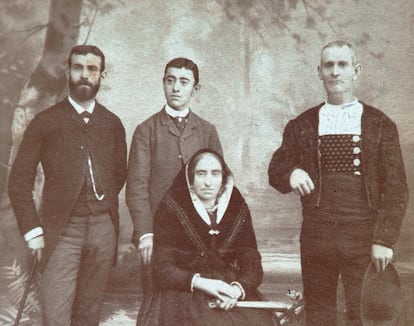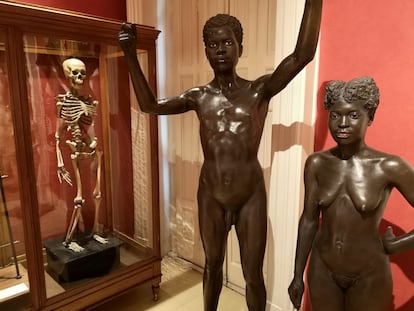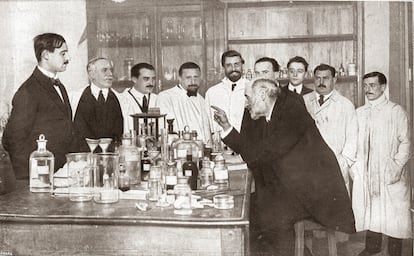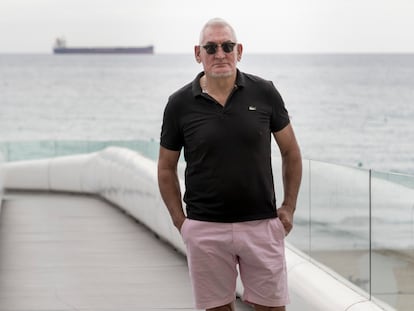The Spanish explorer who desecrated graves in the name of science
The 19th-century naturalist Domingo Sánchez spent 13 years in the Philippines, sending back animal and human samples to build up museum collections and exhibitions

Domingo Sánchez first saw the sea at age 25. “The spectacle of the sea,” he would recall in amazement, years later. He was the son of “honest farmers” and had worked as a goatherd back in his home village, Fuenteguinaldo (Salamanca). Domingo had studied thanks to the determination of his mother, a peasant woman who “was addicted to reading” and could quote entire passages from Don Quijote from memory.
On July 22, 1885, Sánchez hugged his parents, mounted a horse and trotted away. Ten days later he was in Barcelona, where he boarded a steamer headed for the Philippines, then a remote Spanish colony that had been named after King Phillip II.
The Spaniard was starting out a new life as a collector of exotic animals for the Ministry of Overseas Affairs. “I was flattered by the thought of being a naturalist explorer, and by the fact that this profession would enable me to experience real-life episodes out of the novels of Jules Verne and Mayne Reid that I was so fond of,” he wrote.
Sánchez left the Philippines over a decade later, after having sent to Spain an entire zoo’s worth of dead animals as well as numerous human remains, some of which are still on display today at the National Anthropology Museum in Madrid.

His memoirs, plucked out of oblivion by an association based in his home village, do not conceal the shady origin of these items. Rather on the contrary. In the Philippines, Sánchez would introduce himself as a naturalist explorer scouring the islands “on the King’s orders, collecting plants and animals to make medicine to cure disease.” But his real obsession was with human remains, reflecting the 19th century’s obsession with anthropology.
In his autobiography, Sánchez recounts a 1890 expedition to rob bodies from the Tagbanwa, the inhabitants of Palawan island. “I wasn’t very afraid of those little men, half-Malay, half-Black, who looked upon me with great respect and for whom my rifle was a terrible weapon,” he wrote. “I was not unaware that what I was trying to do represented the greatest of crimes for those poor people. The desecration of their graves, the desecration of their dead, was the biggest offense imaginable against them, and it would have justified any attack, any kind of reprisals. But the benevolent, compassionate man had left my body. Only the naturalist was left behind, and to him, obtaining those samples deserved some sort of sacrifice. I spent that night projecting and planning the theft, because theft is what it was,” writes Sánchez in his memoirs.
The following night, when everyone slept in the hamlet of Iüahit, Sánchez and his assistant crept into the sacred cemetery of the Tagbanwa, stole a coffin and got away on a boat. From the shoreline they saw a plume of smoke rising in the sky, illuminated by flames. “Somebody found out about the desecration, probably warned other members of the tribe, and agreed to set our house on fire, thinking perhaps that we were still inside. Even if that was the case, I would never think of calling those wretched people bandits or criminals for seeking revenge for the profanation of their dead. Many peoples of the world who boast of being civilized and cultivated would have proceeded in the same manner, and perhaps even more cruelly. The fact of the matter is that we made it safe, and we saved the booty. That coffin was a good option,” reads the autobiography.

Mercedes Sánchez, 78, keeps the original manuscript handwritten by her great-uncle (who died in 1947) inside her home in Fuenteguinaldo. The memoirs take up two hefty volumes that she inherited along with a set of photographs and other notes. “We used to call him grandfather because he didn’t have any grandchildren of his own. He would bring us candy and sit us on his knee,” recalls Mercedes in a telephone conversation from Alicante, where she is spending her retirement years.
The local association Amigos del Castro de Irueña recovered Sánchez’s memoirs, published them last year, and are working to give them greater exposure. “I’m reading them now for the first time,” admits his great-niece.
The manuscript, titled Historia vulgar algo novelesca de un naturalista médico español (or An ordinary, somewhat fantastic tale of a Spanish naturalist doctor), contains a succession of hunting expeditions. Sánchez would shoot down anything that crossed his path: monkeys, armadillos, alligators, bats, otters, porcupines, black storks. He didn’t shrink away from anything. On one occasion, he required four men to help transport a python he’d just hunted down. During his expeditions through the jungle, he would stay at missionary convents or at the homes of Spanish settlers. One day in 1892, he stayed at the home of a man in Mamburao, a middle-sized town on the island of Mindoro. “In the afternoon we dug up the skeleton of a young Black girl whom my host had watched get buried,” writes Sánchez.
On a recent Wednesday, the National Anthropology Museum was practically empty due to the coronavirus pandemic. The so-called Room of the Origins of the Museum does precisely that, take visitors back to 1875, the year that King Alfonso XII inaugurated the building. Inside an old display case, there are two skeletons standing side by side: those of a female orangutan and of a Filipina woman. Hers was one of the human bodies brought back to Spain by the explorer from Salamanca.
“The female skeleton is from the island of Luzón. All we know is that it was sent by Domingo Sánchez, but we don’t know when or how,” explains a spokesperson for the museum, which is overseen by the Culture Ministry. “The items in the Physical Anthropology collection have yet to be investigated. Their origin is very complex and hazy.”
Many of the samples obtained by the explorer arrived in Madrid for the General Exposition of the Philippine Islands, held in 1887. Sánchez sailed from Manila on April 1 of that year, on a steamer whose deck was filled with cages containing live animals, including monkeys, deer, pythons and carabaos, a buffalo-like grazing mammal. Up near the bow, there was a multitude of birds, especially parrots and magpies. Among all these animals, there was also a group of 43 indigenous people who were getting paid to go on display at Madrid’s Retiro Park.
María Cristina, the queen regent, solemnly opened the Expo on June 30, 1887 at the park’s Crystal Palace, which was built for the occasion. At night, the park would light up with the recently installed electricity, fascinating everyone who looked on. News reports of the day talked about more than 30,000 visitors a day.
The historian Luis Ángel Sánchez Gómez analyzed the circumstances surrounding the exhibition in his 2003 book Un imperio en la vitrina (or An empire in the showcase). Over the course of just a few weeks, three out of the 43 Filipinos died, and a baby was born. They were all sleeping in Retiro Park. One of the deceased women, Dolores Nessern, was a Catholic and she was buried at La Almudena cemetery. The newspaper La Iberia described the ceremony thus: “The lifeless remains of the young island woman were taken to the East cemetery, where religion and science battled hard over them. In the name of anthropological and ethnographic studies, very profound doctors meant to snatch the body and study it in the dissection room, and later deposit the bones inside a museum hall. The priest bravely fought for those remains.”

“Body snatching was relatively common,” underscores Sánchez Gómez, of Madrid’s Complutense University. This historian brings up the case of Doctor Pedro González Velasco, founder of the National Anthropology Museum, who had a small palace built next to the old cemetery in the Basque city of Zarautz, where he would sometimes venture at night with the French anthropologist Paul Broca to steal craniums from the ossuary. It was 1862, and there were theories in vogue linking the shape of a person’s head with the alleged superiority of specific races. The skulls of Basque people, deemed to be primitive, were in high demand among some anthropologists. And if this required stealing them, then so be it. “It was clear that it was not a morally acceptable, or a legal, thing to do, regardless of whether it was being done in Europe or in ‘wild’ territory, but they assumed that it was justified because of the scientific interest involved,” explains Sánchez Gómez.
Domingo Sánchez returned definitively from the Philippines in 1898, after spending 13 years there. He fled with his wife, Encarnación, following the victory of the Filipino uprising that ended more than three centuries of Spanish rule.
The National Museum of Anthropology still stores nearly 40 human skulls sent by Sánchez, according to a list drawn up by the museum at this newspaper’s request. The National Museum of Natural Sciences, also in Madrid, holds some of the animal specimens collected by the explorer, including monkeys, bats and a tamarao.
But most of Domingo Sánchez’s “treasure” no longer exists. On April 28, 1897, the bells of Manila cathedral went off to signal a fire that ended up devouring four city blocks. The flames reached the Inspectorate General of Forestry of the Ministry of Overseas Affairs, which stored over 5,000 jars containing animals preserved in alcohol. “It was a terrible thing to watch,” wrote Sánchez. “The flames reduced to ash those beautiful collections representing my work of nearly 12 years. My anthropology collection, made up of nearly 500 skulls, a few skeletons, many pelvises and other human remains were also burnt down.”
Sánchez recalls that one time, after snatching human remains from a cemetery in the mountains in the north of Luzón, he felt remorseful: “I didn’t feel at ease in that place. It was as though my conscience was accusing me of stealing those people’s treasure, of desecrating the remains of their ancestors. Behind the naturalist, there peeked out the man who presumed to be honest and just. I was starting to be mortified by notions of consideration and charity. But it was no longer possible to go back, nor was I thinking about it. And I resolved to leave that place as soon as possible.”
The old explorer was 76 and working on a clean copy of his memoirs when the Spanish Civil War broke out. He was in Madrid, himself turned into “a walking skeleton” by hunger, and outraged by the assassinations of priests, monks and nuns “under the Reds.” Sánchez, who studied natural sciences before emigrating to the Philipines and who finished his medical studies at age 40, had started to work in 1903 at the lab of the famous neuroscientist Santiago Ramón y Cajal, then located in the same building that today displays the skeleton of the Filipina woman. During the war, Sánchez studied the structure of insects' nervous systems under the microscope.
“This pleasant task was frequently disturbed by the sound of cannon, by exploding howitzers, by the shots of anti-aircraft missiles and machine guns,” he wrote with sadness. “There is no greater ferocity than the one on display during the cruel and fratricide war we have just endured. I never could have thought that our dear, chivalrous Spain could hold so much ferocity and shamelessness, so much moral misery! Our fellow countrymen, who have sponsored and committed such repugnant crimes or witnessed them with glee, have far surpassed the most savage and bloodthirsty Igorotes from the mountains in the north of Luzón in the Philippines.”
English version by Susana Urra.
Tu suscripción se está usando en otro dispositivo
¿Quieres añadir otro usuario a tu suscripción?
Si continúas leyendo en este dispositivo, no se podrá leer en el otro.
FlechaTu suscripción se está usando en otro dispositivo y solo puedes acceder a EL PAÍS desde un dispositivo a la vez.
Si quieres compartir tu cuenta, cambia tu suscripción a la modalidad Premium, así podrás añadir otro usuario. Cada uno accederá con su propia cuenta de email, lo que os permitirá personalizar vuestra experiencia en EL PAÍS.
¿Tienes una suscripción de empresa? Accede aquí para contratar más cuentas.
En el caso de no saber quién está usando tu cuenta, te recomendamos cambiar tu contraseña aquí.
Si decides continuar compartiendo tu cuenta, este mensaje se mostrará en tu dispositivo y en el de la otra persona que está usando tu cuenta de forma indefinida, afectando a tu experiencia de lectura. Puedes consultar aquí los términos y condiciones de la suscripción digital.
More information
Últimas noticias
Most viewed
- Reinhard Genzel, Nobel laureate in physics: ‘One-minute videos will never give you the truth’
- Oona Chaplin: ‘I told James Cameron that I was living in a treehouse and starting a permaculture project with a friend’
- Pablo Escobar’s hippos: A serious environmental problem, 40 years on
- Charles Dubouloz, mountaineering star, retires at 36 with a farewell tour inspired by Walter Bonatti
- Why we lost the habit of sleeping in two segments and how that changed our sense of time










































